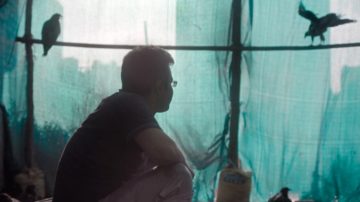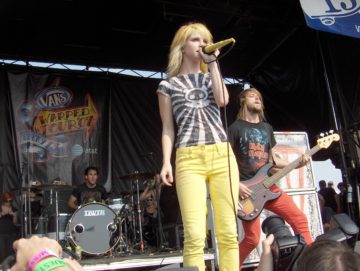Category: Recommended Reading
Burt Bacharach (1928 – 2023) Composer
Rosalyn Pope (1938 – 2023) Civil Rights Activist
Sunday Poem
The Lesson of the Sugarcane
My mother opened her eyes wide
at the edge of the field
ready for cutting.
“Take a deep breath,”
… she whispered,
“There is nothing as sweet:
Nada más dulce.”
… Overhearing,
Father left the flat he was changing
in the road-warping sun,
and, grabbing my arm, broke my sprint
toward the stalk:
“Cane can choke a little girl: snakes hide
where it grows over your head.”
And he led us back to the crippled car
where we sweated out our penitence,
for having craved more sweetness
then we were allowed,
more than we could handle.
by Judith Ortize Cofer
from Touching the Fire — Fifteen Poets of
Today’s Latino Renaissance
Anchor Books, 1998
Saturday, February 11, 2023
Beyond Borders
 Adam Shatz on Adolfo Kaminsky in the LRB:
Adam Shatz on Adolfo Kaminsky in the LRB:
In the spring of 1944, a young man was stopped at a checkpoint of the Pétainist milice outside the Saint-Germain-des-Prés metro station. According to his identity card, he was Julien Keller, aged seventeen, a dyer, born in the département of the Creuse. The bag he was carrying contained dozens of other fake identity papers. But he was confident that the police had no idea how frightened he was because he had learned to affect an air of serenity. ‘I also knew, with certainty, that my papers were in order,’ he recalled many years later. After all, ‘I was the one who had made them.’
‘Julien Keller’ was the nom de guerre of Adolfo Kaminsky, who died in Paris last month aged 97. It was largely thanks to him that the German-occupied zone of wartime France was flooded with false documents. The Occupation authorities were on his trail, but they never suspected that the forger they were after was a teenager. (He was actually eighteen, but claimed to be a year younger to avoid conscription into the Compulsory Work Service.) Kaminsky worked out of a laboratory on the rue des Saints-Pères, disguised as an artist’s studio. Housed in a tiny attic, it belonged to the ‘6th’, a secret section of the General Union of Israelites of France (UGIF), an organisation the Vichy regime had set up and financed with money and property confiscated from Jews. The UGIF pretended to be a humanitarian outfit but would be instrumental in organising the deportation of the Jewish population. The network of the 6th set out to undermine its parent organisation, resisting the Occupation and forging links with various Resistance groups: communists, Zionists and supporters of Charles de Gaulle. Over the course of the war, the 6th helped to save as many as ten thousand Jews from deportation.
More here.
After Independence, Algeria Launched an Experiment in Self-Managing Socialism

Hall Greenland in Jacobin:
There is a famous concluding scene to Gillo Pontecorvo’s classic 1966 film The Battle of Algiers. After witnessing the French paratroopers “win” the battle by a combination of torture and murder over the previous hour and a half, the film climaxes with the residents of the Casbah surging out into the city with their rebel flags and banners blowing in the wind proclaiming independence and freedom for Algeria.
This was no sop to those of us who like a Hollywood-type happy ending but historical truth. Despite the rout in 1957 of the pro-independence Front de Libération Nationale (FLN) in the actual battle of Algiers, the people themselves went on organizing.
When the French president Charles de Gaulle made his visit to Algeria in December 1960, the people of Algiers and half a dozen other cities throughout the country exploded into mass manifestations to impress on him their unbreakable determination to be free.
It was not the last spontaneous intervention of ordinary Algerians in the fate of their country. When independence came in 1962, most of the million European settlers decided to emigrate rather than live under Algerian rule. They left the country bereft of doctors, engineers, technicians, and teachers.
They also left behind them a trail of destruction. It was not only the terrorist OAS (Secret Army Organization) which wreaked this vengeance, killing thousands of unarmed Algerians. Farmers and businessmen also destroyed machinery and wrecked buildings as they departed.
The abandonment and destruction of the settler farms meant that Algeria faced starvation as the settlers had appropriated the best land. In addition, the French counterinsurgency had forced more than two million Algerians off the land as vast swathes of the countryside were cleared of villages and farms for free-fire zones.
Into this impending famine stepped the hundreds of thousands of Algerian farm workers who took over the abandoned farms and managed them themselves.
More here.
The Carbon Triangle
 Jeremy Wallace in The Polycrisis:
Jeremy Wallace in The Polycrisis:
China has ended zero-Covid. The resultant viral tsunami is crashing through China’s cities and countryside, causing hundreds of millions of infections and untold numbers of deaths. The reversal followed widespread protests against lockdown measures. But the protests were not the only cause—the country’s sagging economy also required attention. Outside of a few strong sectors, including EVs and renewable energy technologies, China’s economic dynamo was beginning to stutter in ways it had not in decades.
Whenever global demand or internal growth faltered in the recent past, China’s government would unleash pro-investment stimulus with impressive results. Vast expanses of highways, shiny airports, an enviable high-speed rail network, and especially apartments. In 2016, one estimate of planned new construction in Chinese cities could have housed 3.4 billion people. Those plans have been reined in, but what has been completed is still prodigious. Hundreds of millions of urbanizing Chinese have found shelter, and old buildings have been replaced with upgrades.
The scale of construction has been so prodigious, in fact, that it has far exceeded demand for housing. Tens of millions of apartments sit empty—almost as many homes as the US has constructed this century. Whole complexes of unfinished concrete shells sixteen stories tall surround most cities. Real estate, which constitutes a quarter of China’s GDP, has become a $52 trillion bubble that fundamentally rests on the foundational belief that it is too big to fail. The reality is that it has become too big to sustain, either economically or environmentally.
More here.
Maus Now
Rachel Cooke at The Guardian:
 Spiegelman, as it happens, appears in the most interesting piece in the book: a Q&A with the writer David Samuels from 2013. If Samuels, who prefers to make mini-speeches than to ask to-the-point questions, comes off like a bit of jerk, Spiegelman is ever zippy and contrarian, carefully explaining that, for him, being Jewish means carrying on the traditions of the Marx Brothers and the cartoonist Harvey Kurtzman (in a poll, most Jewish Americans had said it meant remembering the Holocaust). He’s fascinating about the creation of the state of Israel – and seemingly uninterruptible on the subject, even by Samuels. But elsewhere, our celebrated author hardly exists; his narrative has taken on a life of its own. Turning the collection’s pages, I was brought back to my student days, when the dead hand of critical theory threw a black polo neck over even the most enjoyable of texts, shrouding them in darkness. Maus tells the worst story of all; at moments, it’s almost unbearable. Yet its very existence is a kind of light, extraordinary and transfiguring. This may be something the contributors to Maus Now are apt to forget.
Spiegelman, as it happens, appears in the most interesting piece in the book: a Q&A with the writer David Samuels from 2013. If Samuels, who prefers to make mini-speeches than to ask to-the-point questions, comes off like a bit of jerk, Spiegelman is ever zippy and contrarian, carefully explaining that, for him, being Jewish means carrying on the traditions of the Marx Brothers and the cartoonist Harvey Kurtzman (in a poll, most Jewish Americans had said it meant remembering the Holocaust). He’s fascinating about the creation of the state of Israel – and seemingly uninterruptible on the subject, even by Samuels. But elsewhere, our celebrated author hardly exists; his narrative has taken on a life of its own. Turning the collection’s pages, I was brought back to my student days, when the dead hand of critical theory threw a black polo neck over even the most enjoyable of texts, shrouding them in darkness. Maus tells the worst story of all; at moments, it’s almost unbearable. Yet its very existence is a kind of light, extraordinary and transfiguring. This may be something the contributors to Maus Now are apt to forget.
more here.
The Essential Colette
Sadie Stein at the NY Times:
 Colette was not merely the most famous writer of her day, but one of the most famous people, period. A demimondaine with a shocking reputation, by the time of her death, in 1954, Colette was an institution, the first French woman of letters ever honored with a state funeral. (The church denied her a Catholic burial on the grounds of her multiple divorces.)
Colette was not merely the most famous writer of her day, but one of the most famous people, period. A demimondaine with a shocking reputation, by the time of her death, in 1954, Colette was an institution, the first French woman of letters ever honored with a state funeral. (The church denied her a Catholic burial on the grounds of her multiple divorces.)
By turns revolutionary and retrograde, liberated and conservative, a traditionalist who defied labels and loved a title, Colette was nothing if not contradictory. Both her life (81 years long) and her body of work (which exceeded 40 books) were epic, and given that her writing was so often autobiographical, the two were inextricably conflated in the public mind. But if anything, her notoriety obscured the greatness of her prose: Her event-filled life often overshadowed the accomplishments of her best-selling fiction.
more here.
A Free Spirit And A Fearless Artist: Colette At 150
‘Breasts and Eggs’ Made Her a Feminist Icon. She Has Other Ambitions
Joshua Hunt in The New York Times:
 On the last Friday in November, in the afterglow of a literary awards ceremony, the novelist Mieko Kawakami held court in a banquet hall at the Imperial Hotel in Tokyo, wearing a tweed Gucci dress, clutching an Hermès Birkin handbag and sipping a glass of domestic beer she would never quite finish. Each time she raised the drink to her lips, another writer, editor or publicist came along to distract her from it. Kawakami, who is 46, greeted them each with a degree of warmth that made it hard to tell which were strangers and which were her friends. “I’m a graduate of hostess university,” she said, recalling her years spent working at a bar where she kept men company as they drank. More than two decades later, the skills she honed in the boozy, neon-lit back alleys of Osaka — the ability to observe and to listen with acute curiosity — are still apparent in her best-selling novels. “You can see where that sensitivity arises from in her work,” the translator David Boyd told me. “She sees all the angles.”
On the last Friday in November, in the afterglow of a literary awards ceremony, the novelist Mieko Kawakami held court in a banquet hall at the Imperial Hotel in Tokyo, wearing a tweed Gucci dress, clutching an Hermès Birkin handbag and sipping a glass of domestic beer she would never quite finish. Each time she raised the drink to her lips, another writer, editor or publicist came along to distract her from it. Kawakami, who is 46, greeted them each with a degree of warmth that made it hard to tell which were strangers and which were her friends. “I’m a graduate of hostess university,” she said, recalling her years spent working at a bar where she kept men company as they drank. More than two decades later, the skills she honed in the boozy, neon-lit back alleys of Osaka — the ability to observe and to listen with acute curiosity — are still apparent in her best-selling novels. “You can see where that sensitivity arises from in her work,” the translator David Boyd told me. “She sees all the angles.”
The awards ceremony was hosted by Shueisha, a major Japanese publishing house that recruited Kawakami as a judge, confirming her as an arbiter of taste. “One of the reasons my boss pleaded and pleaded for Kawakami-san to judge for our prize is because of her fame and her popularity among young Japanese writers,” said Yuki Kishi, a literary editor at Shueisha. In the time since Kawakami acquiesced to that role, more women had submitted unpublished manuscripts for consideration, Kishi told me, and more of them took risks concerning voice and content. “A lot of people look up to Kawakami-san’s writing and her style and her energy and her buntai (literary style),” Kishi said as we left the banquet hall. “We want to be her.” What Kawakami wants, however, is to confound expectations by writing books that are at times provocatively against type, as if to prove that there is no category that can contain her.
“I’m not an Olympic athlete,” she told me. “Literature doesn’t represent anything.”
More here.
10 most famous people of the Harlem renaissance
Anirudh in Learnordo-newtonic:
 Centered at the Harlem neighborhood in New York City, Harlem Renaissance was an African American movement which peaked around the mid-1920s and during which African Americans took giant strides politically, socially and artistically. Known as the New Negro Movement during the time, it is most closely associated with Jazz and the rise of African American arts. Know more through the 10 most famous people associated with the Harlem Renaissance.
Centered at the Harlem neighborhood in New York City, Harlem Renaissance was an African American movement which peaked around the mid-1920s and during which African Americans took giant strides politically, socially and artistically. Known as the New Negro Movement during the time, it is most closely associated with Jazz and the rise of African American arts. Know more through the 10 most famous people associated with the Harlem Renaissance.
#6 ZORA NEALE HURSTON
| Lifespan: | January 7, 1891 – January 28, 1960 |
| Role: | Author |
Zora Neale Hurston arrived in New York City in 1925 when the Harlem Renaissance was at its peak and she soon became a prominent figure of the movement. Her writings, more than anyone else, revealed the truth of the black Southern experience as being a native of the rural South she was intimate with black folklore. Hurston was the most prominent female writer of the Harlem Renaissance and her 1937 novel Their Eyes Were Watching God is considered among the most influential works of not only the Renaissance but also of African American and women’s literature.
More here. (Note: Throughout February, at least one post will be dedicated to Black History Month. The theme for 2023 is Black Resistance. Please send us anything you think is relevant for inclusion)
Two Saturday Poems
Dream Deferred
What happens to a dream deferred?
Does it dry up
like a raisin in the sun?
Or fester like a sore—
And then run?
Does it stink like rotten meat?
Or crust and sugar over—
like a syrupy sweet?
Maybe it just sags
like a heavy load.
Or does it explode?
~~~~~~~~~~~~~~~~~~~~~~~
For a Lady I Know
She even thinks that up in heaven
Her class lies late and snores.
While poor black cherubs rise at seven
To do celestial chores.
Friday, February 10, 2023
Lion burger? Tiger tacos? Meet the cell cultured start-up working in exotic meats
Katy Askew at Food Navigator:
 Cultivated meat is often heralded as an emerging alternative to intensive animal agriculture, promising new ways to produce slaughter-free beef, pork or poultry proteins. But one cellular ag start-up is working from a different playbook. Primeval Foods is developing lab-grown exotic meats that, it says, can deliver novel food experiences and health benefits.
Cultivated meat is often heralded as an emerging alternative to intensive animal agriculture, promising new ways to produce slaughter-free beef, pork or poultry proteins. But one cellular ag start-up is working from a different playbook. Primeval Foods is developing lab-grown exotic meats that, it says, can deliver novel food experiences and health benefits.
More here.
Launching a huge dust cloud from the moon could ease global warming
Carissa Wong in New Scientist:
 Launching a dust cloud from the moon to block sunlight reaching Earth could reduce global warming, but such a strategy may require more than a decade’s worth of research before it can be implemented. The risks involved with such an approach in terms of how it could affect agriculture, ecosystems and water quality in different parts of the world are also unclear.
Launching a dust cloud from the moon to block sunlight reaching Earth could reduce global warming, but such a strategy may require more than a decade’s worth of research before it can be implemented. The risks involved with such an approach in terms of how it could affect agriculture, ecosystems and water quality in different parts of the world are also unclear.
Placing more than 100 million tonnes of dust between Earth and the sun to partially block light from reaching our planet has previously been explored as a way to combat climate change. Such dust particles would shade Earth by absorbing light energy or scattering light particles, known as photons, away from Earth.
To achieve this, the dust would need to be placed 1.5 million kilometres from Earth, where the gravitational pull of the sun and our planet cancel out. Here, objects stay at a fixed position known as the first Lagrange point, or L1.
More here.
Yawning gaps in the law empower police to collect and store massive amounts of data, all on the grounds that it might one day turn out useful
Emily Berman in the Boston Review:
 As most people know by now, technology is dramatically reshaping the practice of policing. Consider how an investigation might unfold after a spate of shoplifting incidents at a big-box retail store. Authorities believe the same person is responsible for all of them, but they have no leads on the perpetrator’s identity. In a process known as “geofencing,” the police go to a judge and get a warrant instructing Google to use its SensorVault database—which stores location information on any Google users who have “location history” turned on—to provide a list of all cellphones that were within 100 yards of the store in the one-hour range of each day the robberies took place.
As most people know by now, technology is dramatically reshaping the practice of policing. Consider how an investigation might unfold after a spate of shoplifting incidents at a big-box retail store. Authorities believe the same person is responsible for all of them, but they have no leads on the perpetrator’s identity. In a process known as “geofencing,” the police go to a judge and get a warrant instructing Google to use its SensorVault database—which stores location information on any Google users who have “location history” turned on—to provide a list of all cellphones that were within 100 yards of the store in the one-hour range of each day the robberies took place.
More here.
“Tyrannical Vibes” by Kolb
The World John von Neumann Built
David Nirenberg at The Nation:
 The only recipe for surviving technological change, von Neumann concluded, was relying on “human qualities.” But what are those qualities? What is “human” about them? And how can they help us achieve the political forms and ideals necessary to ensure our survival? Von Neumann and his powers of logic did not address those questions. On the contrary, he encouraged us to imagine a strict identity between mathematics and the human, and he gave us the tools to extend one particular kind of human activity—games of strategy—into ever-greater domains of life. Today, game theory and its computational algorithms govern not only our nuclear strategy but also many parts of our working world (Uber, Lyft, and many others), our social lives (Meta, TikTok) and love affairs (Tinder), our access to information (Google), and even our sense of play. Von Neumann’s ideas about human psychology provided the founding charter for the algorithmic “gamification” of the world as we know it. By concealing the distance between logic and the complexity of being rather than minding the gap, his axiomatized “psychology” heightened the very dangers he feared.
The only recipe for surviving technological change, von Neumann concluded, was relying on “human qualities.” But what are those qualities? What is “human” about them? And how can they help us achieve the political forms and ideals necessary to ensure our survival? Von Neumann and his powers of logic did not address those questions. On the contrary, he encouraged us to imagine a strict identity between mathematics and the human, and he gave us the tools to extend one particular kind of human activity—games of strategy—into ever-greater domains of life. Today, game theory and its computational algorithms govern not only our nuclear strategy but also many parts of our working world (Uber, Lyft, and many others), our social lives (Meta, TikTok) and love affairs (Tinder), our access to information (Google), and even our sense of play. Von Neumann’s ideas about human psychology provided the founding charter for the algorithmic “gamification” of the world as we know it. By concealing the distance between logic and the complexity of being rather than minding the gap, his axiomatized “psychology” heightened the very dangers he feared.
more here.
It’s easy to focus on what’s bad — ‘All That Breathes’ celebrates the good
John Powers on NPR:
 In Anne Lamott’s book on writing, she tells a great story about facing tasks that seem overwhelming. Her 10-year-old brother was doing a big school project on birds, and as the deadline loomed, he became paralyzed by how much he still had to do. His father put his arm around him and gave him a piece of advice, “Bird by bird, buddy,” he told him. “Just take it bird by bird.”
In Anne Lamott’s book on writing, she tells a great story about facing tasks that seem overwhelming. Her 10-year-old brother was doing a big school project on birds, and as the deadline loomed, he became paralyzed by how much he still had to do. His father put his arm around him and gave him a piece of advice, “Bird by bird, buddy,” he told him. “Just take it bird by bird.”
This useful life lesson takes literal form in All That Breathes, a wonderful new documentary that arrives on HBO and HBO Max garlanded with international awards. Directed by Shaunak Sen — and ravishingly shot by Ben Bernhard — this inspiring film takes us inside the lives of two ordinary seeming Muslim brothers in Delhi who are actually extraordinary in their dedication to doing good in a city teetering on the edge of apocalypse.
The brothers are named Saud and Nadeem, the former friendly, the latter a little grumpy. Along with their somewhat comical sidekick, Salik, they devote themselves to a project they began as kids: protecting the bird of prey known as the black kite, a glorious, hovering creature widely detested as a scavenging nuisance. Day after day, ailing and injured kites arrive at their homemade infirmary where the trio nurses them until they’re able to fly back into the urban wild.
More here. (Note: An absolute MUST watch)
The Fierce, Lasting Influence of Paramore
Carrie Battan at The New Yorker:
 The tides of influence in music history move in unexpected ways. There are very few towering rock legends or chart-dominating contemporary rappers, for instance, who’ve enjoyed the sprawling and intensifying authority of the pop-punk band Paramore. The band, which was formed in the mid-two-thousands by a group of Christian teen-agers from the outskirts of Nashville, rose to prominence as emo and pop punk were being commercialized for mainstream audiences. Paramore—fronted by Hayley Williams, a vocal powerhouse with neon-marigold hair and a high degree of emotional athleticism—was a small-town Myspace act that hit it big. By the band’s third album, “Brand New Eyes,” from 2009, it had been nominated for a Grammy and included on the “Twilight” soundtrack. The following year, departing bandmates condemned it for being a “manufactured product of a major label.” No band had ever put the “pop” in “pop punk” more effectively than Paramore.
The tides of influence in music history move in unexpected ways. There are very few towering rock legends or chart-dominating contemporary rappers, for instance, who’ve enjoyed the sprawling and intensifying authority of the pop-punk band Paramore. The band, which was formed in the mid-two-thousands by a group of Christian teen-agers from the outskirts of Nashville, rose to prominence as emo and pop punk were being commercialized for mainstream audiences. Paramore—fronted by Hayley Williams, a vocal powerhouse with neon-marigold hair and a high degree of emotional athleticism—was a small-town Myspace act that hit it big. By the band’s third album, “Brand New Eyes,” from 2009, it had been nominated for a Grammy and included on the “Twilight” soundtrack. The following year, departing bandmates condemned it for being a “manufactured product of a major label.” No band had ever put the “pop” in “pop punk” more effectively than Paramore.
more here.
